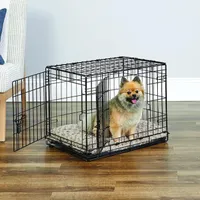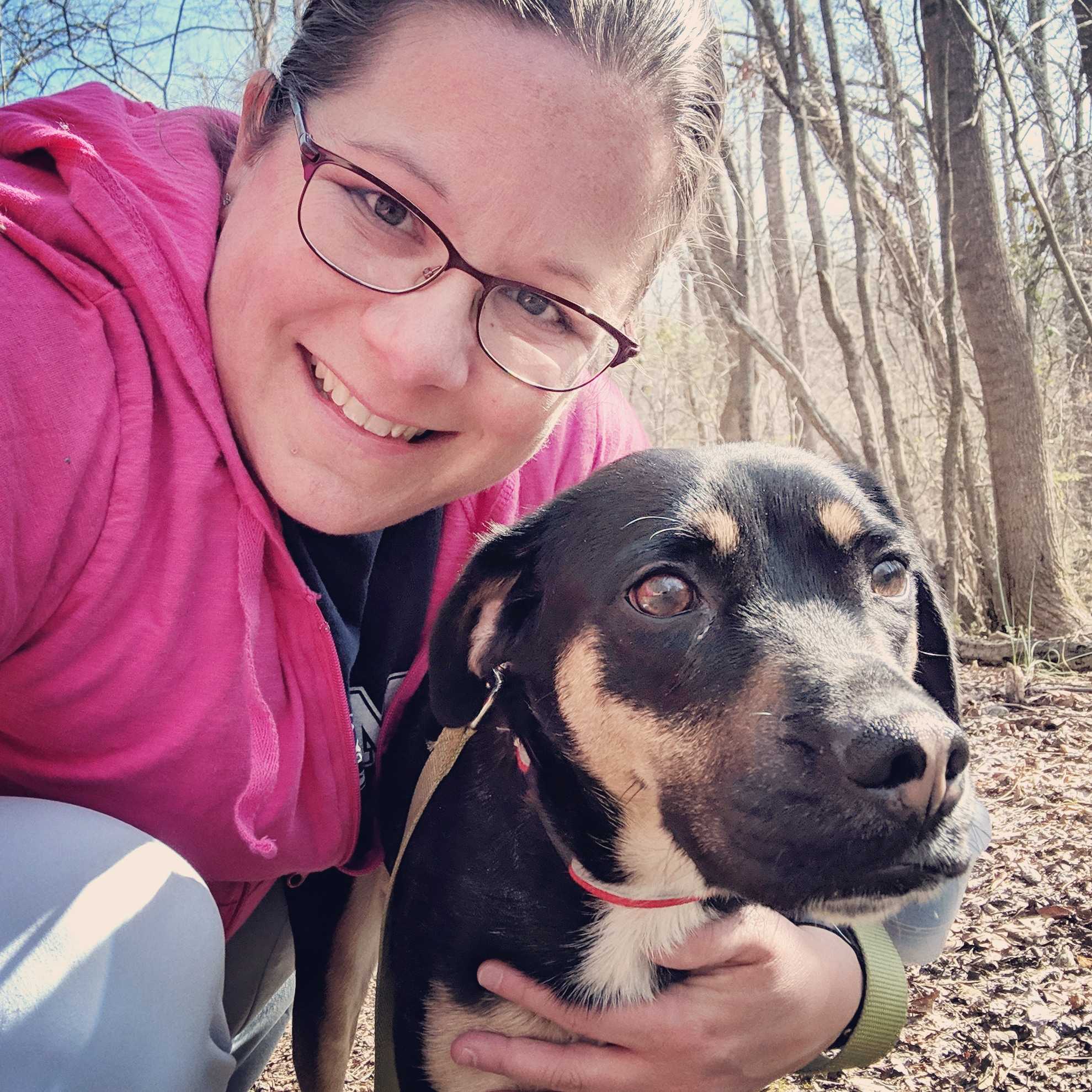How to get a puppy to sleep through the night: 5 tips from a vet
How to get a puppy to sleep through the night just got a whole lot easier with these simple tips from an expert vet.

Figuring out how to get a puppy to sleep through the night is likely high on your priority list if you’ve just welcomed a new fur friend into your family and they’re struggling to settle at bed time.
Just like babies, young puppies need a lot of sleep — around 18-20 hours a day — but it’s normal for them to feel anxious during the first few weeks in a new environment and find it hard to drift off when their humans aren’t around. The best puppy sleep aids can really help with this, but there are other things you can do to ensure they get the rest they need.
Along with strict bedtime routines, you’ll also want to be careful about when you play with your puppy and when you feed them as all of these things can impact on sleep. While bringing home a new puppy for the first time can feel daunting, there are some simple things you can do to help get their sleep schedule on track.
Below, expert vet Dr. Catherine Barnette shares five of her favorite tips to help puppies drift off to the land of sweet dreams — and we love that they’re both simple and effective. Let’s take a look…
How long until a puppy can sleep through the night?
Even if you do everything right, your puppy is not going to be able to sleep through the night immediately. Puppies have small bladders, and they don’t concentrate their urine as efficiently as older dogs. Therefore, most young puppies can’t make it through the night without at least one bathroom break.
There’s a helpful rule of thumb that you can use to predict how many potty breaks your puppy will need during the night. In general, the number of hours your puppy can “hold it” is equal to their age (in months) plus one. For example, a three-month-old puppy can go about four hours between potty breaks. A six-month-old puppy can go roughly seven hours between potty breaks.
This rule isn’t set in stone, though, and there are always exceptions. For example, some puppies hold their urine and stool longer than predicted overnight, because they’re sleeping and not eating or drinking. Still, this can be a helpful guideline for setting expectations. Using this rule of thumb, you can reasonably expect to drop your puppy’s middle-of-the-night potty break around the time they’re six or seven months old (depending on how many hours you sleep at night).
Get the best advice, tips and top tech for your beloved Pets
Even if you’re waking up for potty breaks, there are still steps you can take to make the rest of your sleep more restful. Aim for three to four hours of quality sleep, a brief potty break outside, and then three to four more hours of quality sleep. As long as your puppy sleeps quietly before and after their potty break, you will probably still feel well-rested in the morning. Contrast this to an entire night of tossing and turning due to a sleepless puppy, and the benefits should be readily apparent.
How to get a puppy to sleep through the night

1. Give your puppy a lot of exercise, especially in the evenings
When it comes to our top tips for how to tire out a puppy, exercise is right up there! Just like us humans, puppies sleep better when they’re tired. Long walks, extended play sessions, and other mental and physical stimulation can help burn off some of your puppy’s excess energy and prepare them for a good night’s sleep.
Ideally, your puppy should be active throughout much of the day (except when they’re taking much-needed naps). This may be a challenge if you work outside of the home, but it’s the ideal scenario. If you can’t keep your puppy active all day, though, it’s helpful to focus on providing intense play sessions in the hours immediately before bed.
If you tire your puppy out in the morning, they have all day to recharge with naps. If you tire them out in the evening, they’re more likely to be exhausted at bedtime and sleep through the night. You’ll find lots of ideas for keeping them entertained (and exhausted!) in our guide to the best puppy toys.
The Kong Natural Teething Toy is our best pick for a durable and mentally stimulating toy for your puppy. It doubles up as a slow feeder and a toy and is great for teething pups who chew just about everything.
2. Choose a good bedtime spot for your puppy
While it may be tempting to allow your puppy to sleep in your bed, this habit can be difficult to break! Instead, set up a safe, quiet sleeping space for your puppy. Over time, your puppy will learn to associate this location with sleep, just like we humans associate our bed and bedroom with sleeping.
Most puppies will do best in a crate, once they are accustomed to it. Crate-training can also help with housebreaking, because most puppies are reluctant to urinate or defecate where they sleep. You will want to find a crate that is the ideal size, in order to maximize housebreaking benefits; it should be just big enough for your puppy to stand, turn around, and lay down comfortably. Using a crate that’s too large may teach your puppy to regard one part of the crate as the “bathroom” and one part of the crate as the “bedroom,” which can encourage accidents. Keeping the crate small will discourage your puppy from eliminating in the crate.
Once you’ve purchased one of the best dog crates, add a soft bed. Remember that puppies can be destructive; look for bedding that cannot be easily chewed up or destroyed.
Keep your precious pooch safe and secure with this sturdy double-door metal crate from New World. Versatile and durable, it's ideal for crate training, sleeping or transporting your furkid from A to B.
3. Encourage a positive association with the crate
When bedtime rolls around and you’re tired, it can be tempting to chase your puppy around until you catch them and then toss them hurriedly in their crate. Unfortunately, this can have negative effects! If this becomes your daily bedtime routine, your puppy will quickly learn to resent bedtime and may be less willing to enter the crate or go to sleep.
Positive reinforcement for dogs is super important so try to help your puppy develop a positive relationship with the crate. When it’s time for your puppy to go to the crate at night, place several small dog treats inside and a favorite (safe, indestructible) toy in the crate. Encourage your puppy to enter the crate on their own, with lots of praise and rewards. This will help your puppy develop a positive association with the crate, instead of a negative association.
Avoid using your puppy’s crate as a punishment. While there may be times that you need to confine your puppy for safety, using a crate as punishment or when you are angry may make them reluctant to enter their crate at bedtime.

4. Plan ahead for potty breaks
When it comes to how to potty train a puppy, one of the things you want to avoid is feeding your puppy immediately before bedtime as this will increase the chances that your puppy will need to have a bowel movement in the middle of the night. Instead, aim to feed your puppy dinner a few hours before bedtime, so any overnight walks can be limited to a short “pee break.”
Take your puppy outside as the last step in your bedtime routine. Sending your puppy to bed with an empty bladder will allow you to get more sleep before your puppy’s overnight potty break and will reduce the risk of overnight accidents.
5. Don’t reward bad behavior
It’s human nature. When a puppy begins whining during the night, we’re all tempted to go to the crate and check on the puppy, to whisper “hush,” or to respond in some other way. We may even put a leash on the puppy and take them outside, to be sure that our puppy doesn’t need to go to the bathroom.
Unfortunately, by doing so, we’re training our puppy… just not in the way that we want to train them! Instead, we’re training them that whining in the middle of the night is an effective way to solicit our attention.
If your puppy whines or makes other noise during the night, find a way to ignore it. This may mean that you need to place the crate in a room other than your bedroom! You should only interact or open your puppy’s crate when your puppy is calm and quiet; opening the crate when your puppy is whining only serves to reward that behavior.
Although your puppy will likely need to go outside at some point during the night, don’t encourage them to wake you up in order to do so. That can become a difficult habit to break! Instead, set an alarm for the time you want to take your puppy outside, instead of waiting to be woken up by whining and fussing. As time goes by, you can gradually push this middle of the night wake-up alarm later and later, until you eventually eliminate it completely.
While the early days of having a puppy may seem overwhelming, things will get easier once you figure out how to get a puppy to sleep through the night. Remember that the efforts you put in during the early days will set the tone for the rest of your puppy’s life. Investing time and energy now, during your puppy's first few weeks at home, can go a long way towards making your dog’s entire lifetime more pleasant and stress-free.
If you've just welcomed a new fur friend into your family, be sure to check out our puppy checklist and reasons you have the puppy blues. Or, read why shouldn't you sleep with your dog?

Dr. Barnette graduated from the University of Florida in 2006 where she received both her B.S. in Zoology and her Doctor of Veterinary Medicine (DVM). She has 15 years of clinical experience as a small animal veterinarian, treating dogs, cats, and occasional exotic patients. When she’s not writing content as a freelance veterinary writer, Dr. Barnette lives in southwest Florida with her husband and daughter (plus two cats, a dog, and a rescued dove!) and enjoys kayaking, biking, and hiking.
Dr. Barnette is a graduate of the University of Florida, where she received both her B.S. in Zoology and her Doctor of Veterinary Medicine (DVM). She has 15 years of clinical experience as a small animal veterinarian, treating dogs, cats, and occasional exotic patients. She now works as a freelance veterinary writer, creating educational content for veterinarians, veterinary team members, and dedicated pet owners. Dr. Barnette lives in southwest Florida with her husband and daughter (plus two cats, a dog, and a rescued dove!) and enjoys kayaking, biking, and hiking. Learn more about Dr. Barnette at www.linkedin.com/in/catherinebarnette.
- Kathryn WilliamsFreelance writer



